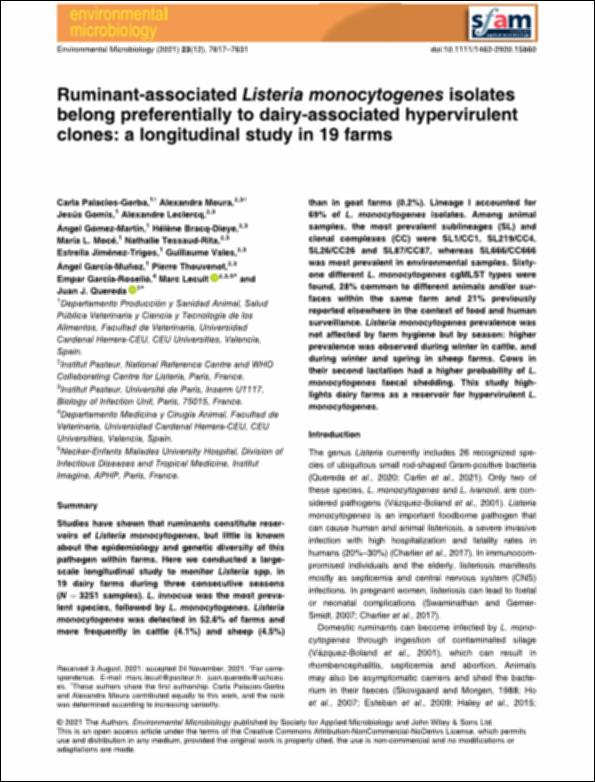Por favor, use este identificador para citar o enlazar este ítem:
http://hdl.handle.net/10637/13422Ruminant-associated "Listeria monocytogenes" isolates belong preferentially to dairy-associated hypervirulent clones : a longitudinal study in 19 farms
| Título : | Ruminant-associated "Listeria monocytogenes" isolates belong preferentially to dairy-associated hypervirulent clones : a longitudinal study in 19 farms |
| Autor : | Palacios Gorba, Carla Moura, Alexandra Gomis Almendro, Jesús Leclercq, Alexandre Gómez Martín, Ángel Bracq-Dieye, Hélène Mocé Cervera, María Lorena Jiménez Trigos, María Estrella García Muñoz, Ángel García Roselló, Empar Quereda Torres, Juan José |
| Materias: | Microbiología veterinaria.; Veterinary microbiology.; Listeria monocytogenes.; Ruminants - Food poisoning.; Rumiantes - Intoxicación por alimentos.; Ganado lechero - Enfermedades.; Dairy cattle - Diseases.; Listeriosis. |
| Editorial : | Society for Applied Microbiology John Wiley & Sons |
| Citación : | Palacios-Gorba, C., Moura, A., Gomis, J., Leclercq, A., Gómez-Martín, Á., Bracq-Dieye, H., Mocé, M. L., Tessaud-Rita, N., Jiménez-Trigos, E., Vales, G., García-Muñoz, Á., Thouvenot, P., García-Roselló, E., Lecuit, M., & Quereda, J. J. (2021). Ruminant-associated "Listeria monocytogenes" isolates belong preferentially to dairy-associated hypervirulent clones: a longitudinal study in 19 farms. Environmental microbiology, vol. 23, i. 12 (04 dec.), pp. 7617–7631. DOI: https://doi.org/10.1111/1462-2920.15860 |
| Resumen : | Studies have shown that ruminants constitute reservoirs of Listeria monocytogenes, but little is known about the epidemiology and genetic diversity of this pathogen within farms. Here we conducted a largescale longitudinal study to monitor Listeria spp. in 19 dairy farms during three consecutive seasons (N = 3251 samples). L. innocua was the most prevalent species, followed by L. monocytogenes. Listeria monocytogenes was detected in 52.6% of farms and more frequently in cattle (4.1%) and sheep (4.5%) than in goat farms (0.2%). Lineage I accounted for 69% of L. monocytogenes isolates. Among animal samples, the most prevalent sublineages (SL) and clonal complexes (CC) were SL1/CC1, SL219/CC4, SL26/CC26 and SL87/CC87, whereas SL666/CC666 was most prevalent in environmental samples. Sixtyone different L. monocytogenes cgMLST types were found, 28% common to different animals and/or surfaces within the same farm and 21% previously reported elsewhere in the context of food and human surveillance. Listeria monocytogenes prevalence was not affected by farm hygiene but by season: higher prevalence was observed during winter in cattle, and during winter and spring in sheep farms. Cows in their second lactation had a higher probability of L. monocytogenes faecal shedding. This study highlights dairy farms as a reservoir for hypervirulent L. monocytogenes. |
| Descripción : | Este artículo se encuentra disponible en la siguiente URL: https://sfamjournals.onlinelibrary.wiley.com/doi/epdf/10.1111/1462-2920.15860 En este artículo de investigación también participan: Nathalie Tessaud-Rita, Guillaume Vales, Pierre Thouvenot y Marc Lecuit. Este artículo pertenece al número especial que lleva por título "One Health Antimicrobial Drug Resistance". |
| URI : | http://hdl.handle.net/10637/13422 |
| Derechos: | http://creativecommons.org/licenses/by-nc-nd/4.0/deed.es |
| ISSN : | 1462-2912 1462-2920 (Electrónico) |
| Cubierto por: | Acuerdo Transformativo - 2021 |
| Fecha de publicación : | 4-dic-2021 |
| Centro : | Universidad Cardenal Herrera-CEU |
| Aparece en las colecciones: | Dpto. Producción y Sanidad Animal, Salud Pública Veterinaria y Ciencia y Tecnología de los Alimentos |
Los ítems de DSpace están protegidos por copyright, con todos los derechos reservados, a menos que se indique lo contrario.


